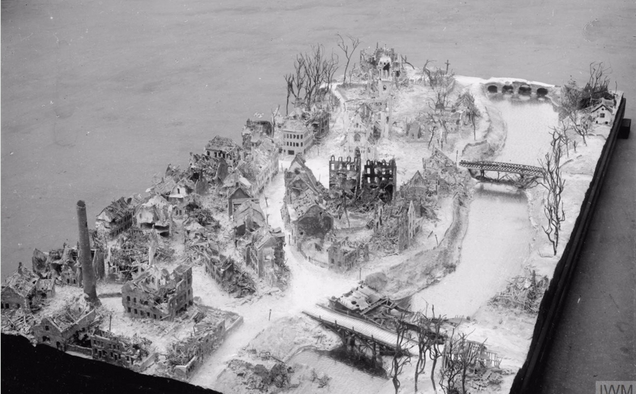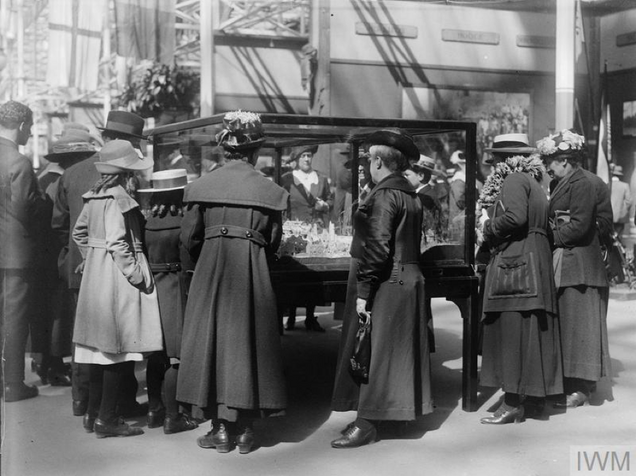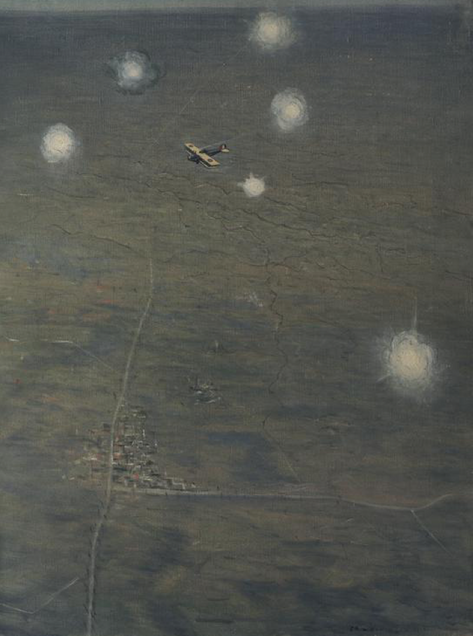Small Twigs and Withered Plants: Mimesis and Miniaturization in World War I Landscapes
by Tobah Aukland-Peck

A Model of a Devastated Town (1920) (fig. 1) revels in the minutiae of disintegration. The walls of the church in its center are blown out, with its bell tower rising precariously above. Around the church are fallen beams, burned roofs, and dead trees—all meticulously crafted by modelmakers. At London’s Imperial War Museum (IWM), which opened originally at the Crystal Palace in 1920, visitors could lose themselves in the wreckage, searching in vain for survivors, puzzling out the words that remained legible over a shop door, and peering in the gaping windows of the homes still standing.1 Like most miniatures, Devastated Town conjured the enchantment of the real. It sought authenticity by using actual sticks for trees, adding resin to render the river shimmering and reflective, and piling sand and dirt in the road. The tangibility of the materials bolstered a feeling of imminence; a year after the Armistice, British citizens could feel the rage of battle anew.2 This model, which purported to show a French town ruined by enemy bombing during World War I, used its mimetic effect to reconstitute an environment pushed beyond the reach of imagination both by distance and the alienating calamity of mechanical warfare. The haptic proximity of the model was borne, however, from a source closer to home.
The supplies that performed the work of the model’s illusion were sourced from debris of British soil: twigs, plants, sand, and dirt taken from city parks. In this substitution of material experience, the local mimicked the distant violence of war. Twigs picked from British parks metamorphosed into the shell-scarred trees of the French battlefront. The model operated in a physically enclosed world and the objects within had a dual referentiality. They interacted with one another—the twigs that represented the trees in Devastated Town were of like size and depended on collective scale to evoke a realistic space. Yet they also engaged with their counterparts in the real world: the viewer could realize the relationship between the twigs and the trees outside.3 The uncanny nature of the model derived from this simultaneous internal and external signification. By using their imagination to explore the physical world of the model, the viewer treated it like real space—a gesture that bypassed the contradiction of internal realism with external material.
A Model of a Devastated Town was one of approximately fifteen models exhibited at the IWM galleries when they opened to the public in 1920. The newly opened museum evoked the experience of war by combining the actual guns used on the battlefront with paintings, watercolors, and prints by war artists, along with photographs, maps, and models. The miniature scale of the models stood in contrast to the full-size objects—like weapons and regimental banners—that had actually seen combat. Susan Stewart’s work on the ontology of the miniature cites the mediated experience of modernity, in which authentic experience is defined by the “myth of contact,” an imaginary gesture rather than the actual bodily experience of the tangible world. “The memory of the body,” she writes “is replaced by the memory of the object.”4 The role of the miniature in the transposition of knowledge from body to mind starts in childhood, when dolls and toys are—like the French village in Devastated Town—animated through the alchemy of material and imagination. This familiarity of the model in early pedagogical exercises for abstract thinking opened up the space of the model as an immersive corollary to these relics of war.

The detail of the models may, at first, link them with the realism of battle paintings in nearby galleries (such as John Singer Sargent’s Gassed [1919]).5 However, the imagination required to animate the models pulled them outside the realm of traditional representation and aligned them, instead, with the most radical experimental image borne of the war: the aerial image. I propose this connection for reasons both practical and theoretical: models in this period were produced based on both aerial photography and topographical maps resulting from aerial reconnaissance. Once the models were installed in the museum, a visitor standing over them would take the place of the aerial eye. The role of scale, an essential aspect of the model’s function as both object and fantasy space, is evidenced in a photograph of visitors at the IWM gathered around the model (fig. 2). The modelmakers ensured that the height of display cases remained consistent and accessible for close contemplation, thereby facilitating a bird’s eye perspective. This was not the view of the soldier but the view of the reconnaissance plane.
The two genres also shared a reliance on imagination as an interpretive and animating force. This way of seeing was particularly relevant to the altered topography of World War I, as subterranean trenches and a reliance on aerial reconnaissance shifted the strategic relationship between space and vision. The view from the ground was limited and unreliable. The view from the air was what mattered.6 If the models provided a familiar entrée to the unfamiliar terrain of war, aerial paintings, as the 1920 IWM catalogue emphasizes, were alienating: “Artists here were guided by no traditions and had to work from eye memory. … They show sights which the imagination must be kindled to realise… It is not to be expected that every groundsman will find air-pictures as lucid as normal landscapes.”7 Notable here is the creative leap. This is a visual strategy that must be learned.

Though battle models have a history that predated the advent of aerial warfare, the physical proximity of A Model of a Devastated Townto aerial paintings and photographs in the IWM galleries recontextualized their format in relation to aerial vision.[8] Images such as Christopher Nevinson’s Over the Lines (1917) (fig. 3)—on display nearby Devastated Town in the Air Force section of the IWM—revealed aerial imagery as schematized rather than representational. Nevinson’s composition has a uniform ground of gray-green and the scant topographical differentiation reiterates the muddy sameness of the front. The staccato lines of white, black, and ochre used to form the town below imply a violent disintegration of the built environment. The horror of war, however, is removed, and the exploding shells in the aerial composition appear as ornamental rather than deadly.
Nevinson’s view incorporated information about roads, trenches, and troops with information indicated by abstract symbols rather than a pictorial match between signifier and signified. The genre of aerial-landscape paintings was facilitated by two mechanical innovations of the early twentieth century that augmented the limits of human vision: reconnaissance flights and aerial photography.9 Its format claimed a scientific lineage which, as the IWM catalogue makes clear, required a trained viewer to make the images lucid.10 Even in the context of an art exhibition, the viewer took on the role of a trained military observer by reading the distant marks of Over the Lines as the details of a ruined town. This is, as the catalogue implies, a drastic departure from the conventions of British landscape painting, where clarity and legibility were highly valued. Landscape imagery, which was vital as an informational tool in past wars, had been rendered obsolete by the symbolic vision of aerial reconnaissance. The explicitness of the miniatures circumvented this troubled relationship between human observation and mechanical vision, presenting a claim for unmediated reality. In the galleries of the IWM, the models translated the remote landscape seen in images such as Over the Lines into a form that reestablished stable topographical vision. Yet their precision and tangibility were an anachronism, and the irony of the models is that they were, unlike aerial paintings and photography, products entirely of the home front.
If authenticity was achieved by some war artists through first-hand experience, the modelmakers, for the most part, had not personally witnessed the episodes or landscapes they were tasked with creating. Instead, for objects such as Devastated Town, the IWM would send the modelmaker maps, aerial photographs, and artist sketches to assist with the production of the scene. Just as the war on the ground became dependent on topographical information gleaned from the air, the maps and photographs used to construct these models in the removed workshops of London were dependent on mechanical vision. The modelmakers had the expertise to translate aerial viewpoints into standard visual conventions. They acted as invisible mediators between the museum visitors and the military, asserting the landscape of war as comprehensible despite the distance from the frontline and the violence of the battle.
The town in Devastated Town was, however, as indistinct as the one in Over the Lines. A later caption notes that the model was intended to represent the war-time condition of a number of French villages and to show the rampant destruction of war to a British populace whose own land, in this period before the Blitz, was relatively untouched.11 Like the nameboard of an obliterated village, the model stood as a record of loss. It showed a landscape that was particular to the war as a whole—as troops and shelling moved through civilian towns in northern France—rather than a specific time or location. The implied reality of the miniature, in its intense detail and promise of a completely enclosed world, seemed to deny its composite nature. Like the literary referents of Barthes’s reality effect, the models marshal excessive detail to conjure a convincing simulacrum of place.12
While the IWM intended to display the efforts of the entire military and civilian population in the war and had sections devoted to domestic efforts, none of the models shown at the Crystal Palace were of British sites. When a modelmaker wrote to the museum to suggest a model of the damage done by the first zeppelin bomb dropped on London, the institution declined, citing space restraints.13 The inclusion of this scene would have disrupted the contrived certainty of models of the war’s terrain. A violent spectacle that had torn through buildings and streets mere miles away from the museum would have broken the enclosure of the models. The safe distance—borne of the models’ aerial viewpoint, miniaturization, and representation of a general type rather than a specific place—would be negated by the immediacy of the local zeppelin damage. The threat of the lived experience would be brought dangerously close to home; imagination would not be necessary to bridge the gap between knowledge and experience.
The simulacra of foreign battlefields were ultimately marshalled as psychological barriers between the field of war and the home front. The clarity of their construction circumvented the necessity of experienced vision required by other documentation of the twentieth century’s first mechanized conflict. They allowed “groundsmen,” as the IWM catalogue notes, to attain lucidity. The models were consistently and repeatedly focused on distant locations and did not threaten the integrity of the British landscape in the face of world war. The supplies that performed this work, however, were physical remnants of the British soil, marking the scene as a foil to the unscathed landscape of Britain. The museum’s lead curator wrote to the superintendent of Hyde Park in 1919:
I beg to inform you that a number of Relief Models showing various portions of the Western Front and War Areas are being prepared by this Department […] To complete these models, it is necessary to insert small twigs and withered plants on a scale suitable to the model. I shall be obliged therefore if you will allow Mr. Ogilvie, the bearer of this letter, to select such small specimens as occasion may demand, it being of course understood that none of these specimens would be taken from flower beds, only from the wilder parts of the park.[14]
Though the miniature world transformed twigs and plants into approximations of foreign terrain, their attachment to British parkland threatened to undo the model’s claim of authenticity. To maintain the illusion of British control over the distant battlefield, it was integral that both the modelmakers, and the war itself, would not disturb the flower beds.
____________________
Footnotes
1. Since 1936, the IWM has been located in Lambeth. The museum vacated the Crystal Palace and moved to South Kensington in 1924. The Crystal Palace at Sydenham was the glass structure designed by Joseph Paxton to house the Great Exhibition of 1851. It was moved from Kensington to Sydenham in 1852.
2. In this way, these models share a history with earlier battle panoramas, such as those exhibited in France and England during the Napoleonic wars. It is important to note that this tradition was modernized during WWI through large-scale photographic panoramas that were similarly intended as mimetic performances; see Martyn Jolly, “Composite Propaganda Photographs during the First World War,” History of Photography 27, no. 2 (2003): 154–65. These experiences, however, were often staged as separate performances, and the models are distinct in their use as part of the newly conceived military museum.
3. Susan Stewart, On Longing: Narratives of the Miniature, the Gigantic, the Souvenir, the Collection (Durham, NC: Duke University Press, 1993), 45.
4. Stewart, On Longing, 134.
5. Gassed (1919) was one of the largest paintings included in the art section of the IWM galleries. Sargent, an American, was commissioned by the British Ministry of Information in 1918 to travel to the front, where he completed research for this work. The painting remains in the collection of the museum.
6. This representational shift is documented by scholars including Bernd Huppauf and Hanna Rose Shell; see Bernd Hüppauf,“Representing Space — Panoramas of World War I Battlefields,” History of Photography 31, no. 1 (2007): 83–84; Hanna Rose Shell, Hide and Seek: Camouflage, Photography, and the Media of Reconnaissance (New York: Zone Books, 2012).
7. Imperial War Museum, Catalogue of Paintings, Drawings and Sculpture (London: Her Majesty’s Stationery Office, 1920), 4
8. Military wargames, which used tabletop surfaces augmented with topographical details to plan troop movements, were invented in Prussia at the turn of the nineteenth century. They were popularized in England by author HG Wells, who published Little Wars, a guide to tabletop war games, in 1913.
9. Caren Kaplan summarizes the scientific and militaristic implications of aerial vision in her chapter about aerial mapping projects in early twentieth-century Iraq; ee Caren Kaplan, Aerial Aftermaths: Wartime from Above (Durham, NC: Duke University Press, 2018), 138.
10. Allan Sekula’s article on Edward Steichen’s role as commander of the aerial-photography branch of the American Expeditionary Force during the First World War is an early contribution to the field of aerial photography. His analysis echoes many of the points that I pull from the IWM catalogue caption, including the “rationalized act of ‘interpretation’” that constitutes any visual interaction with the aerial image;see Allan Sekula, “The Instrumental Image: Steichen at War,” Artforum 14, no. 4 (December 1975): 26–35.
11. While the IWM identifies some images of this model as “A Model of Peronne” I believe that this caption, included with the catalogue entry for the model itself, supersedes this later identification.
12. Barthes proposed the reality effect in a 1968 essay. He originally applied it to literary models. He distinguished between textual details that relate specifically to the main plot—called predictive—and details that are descriptive but superfluous to the story, notations. The extraneous details play upon the reader, building an experience that heightens the sense of the text’s reality, see Roland Barthes,The Rustle of Language (Berkeley, CA: University of California Press, 1989), 141–48.
13. Correspondence from Major C. Foulkes to Charles Ledwidge, January 24, 1922, EN1/1/MOD/001, The Imperial War Museum Archive, London.
14. Correspondence from Major C. Foulkes to Hyde Park Superintendent, February 21, 1919, EN1/1/CPL/020. The Imperial War Museum Archive, London.